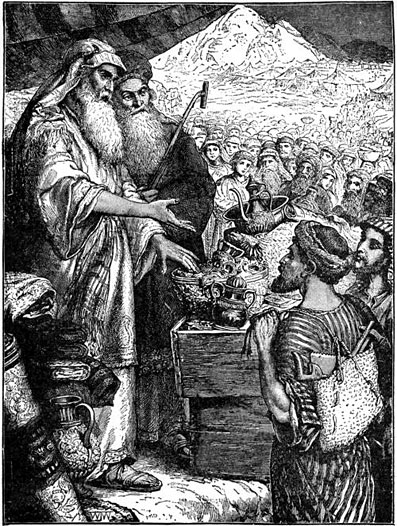Nov
2
2013
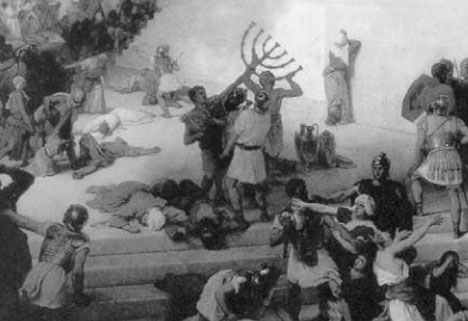
Jesus answered them, “Destroy this temple, and in three days I will raise it up.” (John 2:19)
Every one of God’s houses throughout Bible history has a “former days” and a “latter days.” Each goes through a process of death and resurrection, a “purification by fire.” Following the Bible Matrix, the central “slaying” of every row has a Day 4 symbol, something related to “the governing lights,” the all-seeing eyes of heaven.
Continue reading
Comments Off | tags: AD70, Covenant Theology, David, Ezekiel's Temple, Solomon, Tabernacle, Tabernacle of David, Temple | posted in Bible Matrix, Biblical Theology, The Last Days
Sep
4
2010
or Forbidden Mixtures – 2

NOTE: THIS POST HAS BEEN REMIXED AND INCLUDED IN GOD’S KITCHEN.
You must be logged in to see the rest of this post.
Join now for a year for $15!
Many theologians will tell you that the Old Testament Scriptures have little to say about resurrection. Yet, typologically, they scream about it constantly if we have eyes to see. Many modern conservatives don’t understand the nature of revelation. God paints the same picture of death and resurrection over and over again at both personal and national levels and all these gents do is record how many pixels are in each image.
For a visual blow-by-blow account of this death and resurrection process, get a copy of Bible Matrix and read it twice. Here, I want to concentrate on the significance of Melchizedek in the Last Supper.
Continue reading
2 comments | tags: Abraham, Communion, Ezekiel, Ezekiel's Temple, Genesis, Joseph, Resurrection | posted in Bible Matrix, Biblical Theology, The Last Days, The Restoration Era
Jun
8
2010

“Then all the people shouted with a great shout, when they praised the LORD, because the foundation of the house of the LORD was laid. But many of the priests and Levites and heads of the fathers’ houses, old men who had seen the first temple, wept with a loud voice when the foundation of this temple was laid before their eyes.” Ezra 3:11-12
Doug Wilson writes (Less Glory Is More):
The Bible teaches us that the times of the new covenant are attended with a greater glory than the old covenant, as well as with a greater simplicity. In effect, that simplicity is part of the glory.
Continue reading
2 comments | tags: AD70, Communion, Covenant Theology, Doug Wilson, Ezekiel's Temple, Ezra, Solomon, Totus Christus | posted in Quotes, The Last Days, The Restoration Era
Mar
29
2010
or The Self-Maledictory Oath
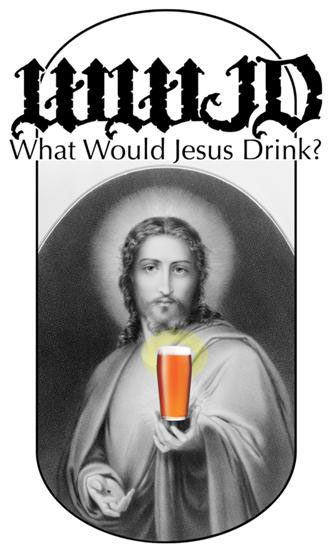
For thus says the LORD God of Israel to me: “Take this wine cup of fury from My hand, and cause all the nations, to whom I send you, to drink it. “And they will drink and stagger and go mad because of the sword that I will send among them.” Then I took the cup from the LORD’s hand, and made all the nations drink, to whom the LORD had sent me…” (Jeremiah 25:15-17)
The content of this post has been revised and included in Bible Matrix II: The Covenant Key.
__________________________________________________________
[1] See Sacramental Doses of Death.
[2] This is the execution of a Covenant curse, so those who fought against Jerusalem were people under the Covenant.
[3]Contrary to popular opinion, I believe that the divided animals substitute for the Canaanites rather than for Abraham, but the birds do substitute for Abraham. The birds are the head of the Covenant, and He is never crushed. Only the serpent’s head is crushed. This also relates to the linen left in Christ’s tomb. The Jew-Gentile body was divided in Abraham and reunited in Christ. See Pass-over and Pass-Through.
[4] See Three Babylons.
[5] This also relates to the disappearance of the pure Covenant-head, the Ark of the Covenant. See The Lost Ark.
Comments Off | tags: Abraham, Ark of the Covenant, Babylon, Covenant Theology, Ezekiel's Temple, Gethsemane, Jeremiah, Numbers 5 | posted in Biblical Theology, The Restoration Era
Feb
10
2010
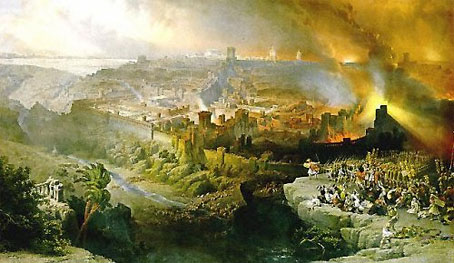
Here’s the last installment of my answers to Brian Simmon’s 50 objections to a first century “coming in judgment” of Christ. You can find a link under Featured Articles that will list them all for you.
46. Abraham still hasn’t inherited the land God promised him (Gen. 13: 15; Acts 7: 5).
Joshua 21:43 “So the LORD gave to Israel all the land of which He had sworn to give to their fathers, and they took possession of it and dwelt in it.”
I don’t see the relevance of Acts 7:5. The Land was promised to his descendants.
Continue reading
1 comment | tags: Dominion, Ezekiel's Temple, Herod, Isaiah, Jeremiah, Matthew, Restoration | posted in Biblical Theology, The Last Days, The Restoration Era
Feb
1
2010

Peter Leithart writes:
Solomon’s temple had windows, but they are mentioned only once, in 1 Kings 6:4. Ezekiel’s description of the visionary temple uses the word “window” twelve times.
Continue reading
Comments Off | tags: Ezekiel's Temple, oikoumene, Peter Leithart | posted in Biblical Theology, The Last Days, The Restoration Era
Jul
3
2009
“Be meticulous to present yourself for the praise of God as an unashamed workman, cutting the word of truth in a straight line.” (II Timothy 2:15)
Is this verse simply teaching that if we “divide up” the Scriptures correctly, we’ll get an AWANA[1] merit badge from God? Hardly. It is flanked by condemnations of those who fight over the Scriptures to no profit, and those whose vain babblings are gangrenous.
Paul speaks of a soldier and a farmer, and then a productive workman. Paul is concerned about building saints and churches, and they are built by a straight and true cutting of the word. Like most of Paul’s statements, there is a very long, fully-loaded freight train of Old Testament history and typology right behind it, and it’s coming right at you, right now.
Continue reading
Comments Off | tags: Darius, David, Esther, Ezekiel's Temple, Nebuchadnezzar, New Jerusalem, oikoumene, Peter, Peter Leithart, Postmillennialism, Revelation, Solomon, Stigmata, Temple, Totus Christus, Worship | posted in Biblical Theology, Christian Life, The Last Days, The Restoration Era
May
20
2009
The Purpose of the Restoration Covenant
“The restoration period is the last era of Israel’s history as the people of God and the climactic period of old covenant. The kingdom of God has grown beyond Israel and spread to the nations, who are the God-appointed protectors of His priestly people. Israel’s loss of independence and submission to Gentile powers was not a backward movement in the kingdom program of God. Abraham had been chosen by God so that through him all the nations of the world could be blessed (Gen. 12:3). In the restoration era, this was fulfilled more than at any other time in Israel’s history. Through the dispersion Jews had spread all over the world and they brought with them the knowledge of the true God.
Continue reading
Comments Off | tags: Babylon, Covenant Theology, Daniel, David, Ezekiel's Temple, Nathan, Persia, Restoration, Temple | posted in Biblical Theology, Quotes, The Restoration Era
Apr
25
2009
For those reading my book, I need to correct a paragraph on p. 289. Although the newly expanded territory measured out the pattern of the Ark, the Ark was in heaven. So restored Jerusalem became the four-cornered Altar of Incense beneath it (the Holy Place/City) and the Empire became the Bronze Altar beneath that.
“The Lord had used the exile to expand His territory. He had scattered His people as the four winds. Jerusalem was now the Temple (the holy city), a rebuilt Altar of Incense. The Empire was now the Land, the four-cornered bronze Altar beneath it.”
This all of course is a type of the New Jerusalem ruling an even greater world in this current age. I’ve also added a diagram.
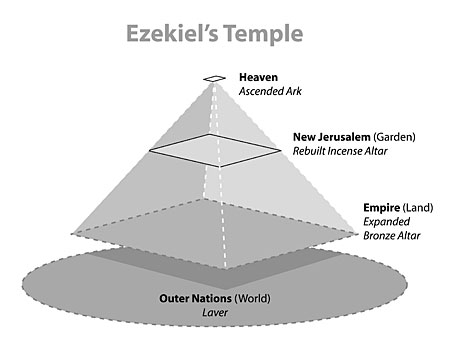
“God claimed the Babylonian Empire as His territory, and began converting Nebuchadnezzar’s new World (Sea) into Land. The kings had failed to continue bringing the riches of the Gentiles under the Covenant, so the Lord expanded the Covenant promise. The expansion would cost Israel her life.”
Comments Off | tags: Ark of the Covenant, Ezekiel's Temple, Incense Altar | posted in The Restoration Era, Totus Christus
Apr
10
2009
James B. Jordan, following the God-given office of Cyrus as shepherd over Israel (Isaiah 44:28), interprets Zechariah 11 as a prediction of events under Greek rule, rather than Roman:
“The wicked Hashmoneans took over the Temple for themselves, and did not give glory to God and restore the true High Priest. The Hashmoneans “buy” the Temple for thirty pieces of silver, but Yahweh rejects their offer, which treats Him and His people as slaves. These evils result in the Jews being broken apart and set at each other’s throats.”1
Either way, the pattern is the same, as the Jews’ apostasy under Greek rule was repeated under Rome, with the “Temple” they sold in the second instance being Christ Himself. Both “Greek” and “Roman” interpretations link the events of chapter 10 to chapter 12, and echo the judgments upon false shepherds by the pre-exile prophets. And in both cases, it is the “Temple” seen by Ezekiel that is being judged. The flock is divided and the Temple made desolate under Antiochus Epiphanes (Greece), and under Christ and Titus (Rome).
The most important factor is that in both events, the Jews’ compromise left them without a true High Priest, and thus no true Atonement.
_______________
See James B. Jordan, The Handwriting on the Wall, p. 585-587.
Comments Off | tags: Antiochus Epiphanes, Atonement, Compromise, Cyrus, Ezekiel's Temple, High Priest, Isaiah, James Jordan, Temple, Zechariah | posted in Biblical Theology







